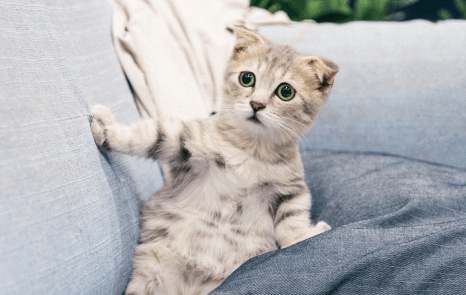
Declawing Advice
Mouse In the House: Speaking of Declawing
Apologies to Shakespeare, but to keep claw or declaw…that is the question. As a feline myself, I feel it’s time I weighed in on this very cat-entious issue.
Listen, I understand that some of my less-refined feline family look at any upholstered surface as a claw-portunity, and that gets to be expensive and understandably unacceptable for the cat’s human staff. The truth is that I myself was once an inappropriate shredder—and nearly as famous for my work as Cindy Clawford.
But here’s the truth of the matter: declawing is not the answer to this problem. First, you should know that scratching is a normal, natural, and necessary behavior for cats, who do it for many reasons:

- Discard layers of old nail growth
- Instinctual marking of territory—clawing releases pheromones (scent)
- Stretching of toes and limbs to maintain strength
- Sign of stress or anxiety (we’ll talk about this in a minute)
Some people think that declawing a cat just means surgically removing the claw nail itself. Unfortunately, that is not the case: declawing actually requires removing the third joint of the cat’s toe. My medical friends here at DCC call it amputation of the third phalanx, or third ‘toe bone.’
ME-OWWWW that sounds painful—and it is. Very.
The other thing is that most veterinarians and veterinary groups—including the American Veterinary Medical Association, and American Animal Hospital Association— oppose declawing as unnecessary and harmful. Many states including New York and New Jersey have even outlawed the practice. And as my kingdom hospital is also a Certified Cat-Friendly Practice with the American Association of Feline Practitioners, we abide by their guidelines and do not perform this procedure. More importantly, you best believe I’d throw a pawsitively catastrophic hissing fit if they DID.
So what can you do if you love cats but also want furniture that doesn’t look like it ticked off a Tasmanian Devil? Here are a few great suggestions that given some patience, will work:
- Provide plenty of appropriate places, posts, and surfaces for your cat to do what comes naturally. There’s an infinite variety of catch scratching options with many different kinds of surfaces, and you’ll want to experiment with a few different ones to see which your cat prefers. In addition to placing these scratching posts and surfaces where your cat currently likes to scratch, you can also try putting them at varying angles and locations (like hanging from a door, flat on the ground, or tilted at an angle) to see what fires up your feline.
- Reward your kitty for scratching in an appropriate place! Both food rewards and praise work well.
- Trim those nails regularly. Your DCC veterinarian or technician can show you how. I can assure you we’ll complain, but I’ll break the cat code this once and tell you that it really doesn’t hurt—we just prefer any kind of grooming to be OUR idea. Nail caps can also be helpful.
- Try aluminum foil, plastic wrap, or double-sided tape. Placed on a piece of furniture where you cat likes to scratch, these deterrents are often very successful in preventing cat-assisted upholstery homicide.
- If you and your veterinarian think the clawing issue may be due to aggression or stress—which is very common—you’ll need to address any kitty conflicts in your household. If your cats don’t occasionally nap together, groom each other, or play together, you could have a Kardasian-worthy feline feud brewing. Separate litter boxes, scratching areas, sleeping perches and such for each cat will help. It may also be a strange cat outdoors that is upsetting your indoor pet. Cats hate paparazzi.
- Make sure you kitty isn’t (*yawn*) bored. Indoor cats especially need regular daily playtime and stimulation or we may find
destructivecreative ways to entertain ourselves.
Here at DCC, we want you to know there are paw-ternatives to giving up your feline friend or the drastic and painful option of declawing. Please don’t hesitate to call on my knowledgeable, veterinary-trained human entourage before you get to that point—they’re here to help!
Keepin’ it fur-real,
Mouse
Official Cat Clinic Spokesmodel